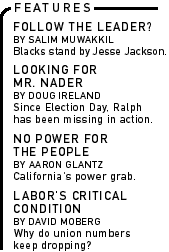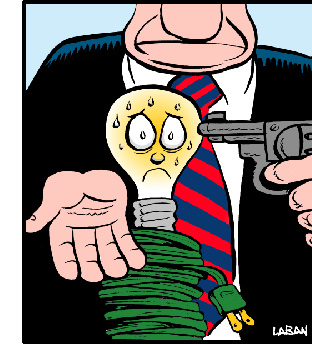

|

|

|

|
| |
 |
|
|
As the economic losses caused by California's energy deregulation plan pile up, it's hard to find anyone these days who would disagree with California Gov. Gray Davis' declaration that the state's 1996 electricity deregulation scheme "is a colossal and dangerous failure." When price caps were first lifted in San Diego last summer, power bills there tripled. "I never thought I'd be pushing socialism," conservative Republican San Diego County Supervisor Bill Horn conceded at the time. "But San Diego is bleeding. When a business is used to paying $300 a month for energy, and now it's paying $1,000, it's going to close." Rolling blackouts have already caused computer giant Intel to freeze its California
The state's two big utility companies, Southern California Edison and Pacific Gas and Electric, say they need a multibillion-dollar, consumer-financed bailout to stave off bankruptcy. Edison and PG&E insist they can't afford the current wholesale price of electricity--which is 10 times the price it was when the utilities were regulated monopolies, before they sold off their power plants to out-of-state companies like Texas-based Enron and Duke Energy of North Carolina. But consumer advocates are quick to point out that both big utilities have unregulated subsidiaries that are making record profits. "These companies have plenty of assets," says Doug Heller of the Santa Monica-based Foundation for Taxpayer and Consumer Rights. "They could bail themselves out." Edison's parent company, Edison International, owns power plants in 13 states and six foreign countries as well as a telephone company in Switzerland and a cable company in Mexico. On January 22, the supposedly bankrupt company reported to the Securities and Exchange Commission that it had $1.9 billion of cash on hand. Meanwhile, PG&E has moved to erect a firewall between its power-producing subsidiary, PG&E National Energy Group, and its money-losing utility company. PG&E National Energy Group owns more than 30 power plants in 10 states and is making tremendous profits by selling to the utility company at grossly inflated rates. Consumer groups also note that PG&E and Edison have already taken $28 billion from ratepayers in the form of a "competitiveness tax" the utilities insisted on as a condition of deregulation in 1996. When consumer groups sponsored a referendum in 1998 to repeal that bailout and re-regulate the market, the two utilities spent more than $40 million--a campaign fundraising record for California--to crush the ratepayer revolt by a 73-to-27 margin. "The idea that the utilities are somehow the victims of deregulation is patently ridiculous," Heller says. "Utility lobbyists wrote the deregulation legislation and have benefited mightily from it." Further evidence of public manipulation comes from the global investment firm Credit Suisse First Boston, which sent a memo to its clients saying the California's rolling blackouts were not caused by shortage--but by the utilities themselves. According to the document, the blackouts were "intended to soften up the legislature and the voters to the need for rate increases." Shortly after the memo was leaked to the press, Morgan Stanley Dean Witter urged investors to buy the utilities' stock, upgrading PG&E's rating to "outperform." Still, there is no doubt that out-of-state generating companies are making the most money. Duke Energy doubled its revenues as deregulation took effect. Enron announced on January 22 that its stock had gone up 89 percent in a year. Another Texas company, Dynegy, tripled its net income. Evidence is mounting that the generating companies are fixing prices. On January 28, the agency that oversees the state's power grid reported that 49 power plants had been turned off, leading to speculation that energy companies are manufacturing artificial shortages in an effort to raise wholesale prices. This pattern is leading some lawmakers to push the idea of publicly owned power. Residents and businesses in Sacramento and Los Angeles, where the electric grid is municipally owned, haven't seen their rates increase at all, and neither public power authority is feeling the pinch of higher wholesale energy prices because both generate their own energy. Demonstrations at PG&E's headquarters in San Francisco have become common, with ever-larger crowds calling for the municipalization of that city's energy system. The protesters say they want PG&E to stand for "Public Gas and Electric." That idea is gaining steam in Sacramento. "There's got to be a California Power Authority," insists state Senate President John Burton, a Democrat from San Francisco. "If we give [the utilities] billions of dollars, we've got to get something in return. Just like I give you a dollar, and you give me a hot dog." Indeed, lawmakers in both parties are taking great pains to portray any utility bailout plan as a give-away. So while a broad consensus has been built for a $5 billion to $10 billion rescue plan, most insist that the state should receive assets of similar worth in return. Such a deal could include the high-voltage power transmission system, a massive hydroelectric dam network in the Sierra Nevada mountains, or ratepayer stock in the utility companies (see below). In any case, such a deal would mean a big rate increase for consumers. The energy crisis also has spawned a renewed push for conservation and renewable energies. Wind and solar power now make up less than 3 percent of California's power grid. Legislators are proposing as much as $1 billion in subsidies for alternative energy and energy conservation. State government has already cut its energy use by 5 percent in an effort to make more energy available to homes and businesses and avoid rolling blackouts. None of this has lessened the appetite for deregulation in other states. According to the Energy Department, 42 states have taken at least one step toward deregulating their energy industry, and no state has reversed course. Price caps will be lifted in New York next year; Illinois, Michigan and Texas are set to eliminate price controls by 2002. States that continue to tightly regulate the energy market are mostly rural ones like Idaho, Nebraska and South Dakota. President George W. Bush is an outspoken proponent of deregulation. It's no coincidence that Enron gave the Republican Party more than $1 million last year, and the company is the president's biggest lifetime campaign contributor. Since taking office, Bush has urged California to gut its landmark environmental laws to facilitate faster construction of more natural gas plants. He also contends the state's energy crisis shows the need for opening Alaska's Arctic National Wildlife Refuge to oil drilling. For his part, Vice President Dick Cheney says California companies should seriously explore building power plants in Mexico, where environmental rules are weaker. After initially balking at the idea, Mexican President Vicente Fox has given his tacit endorsement to the plan. Still, Bush's policies don't represent a big change from the Clinton administration, which refused to cap wholesale prices. Activists say such a step could have brought the crisis under control months ago. The new Republican head of the Federal Energy Regulatory Commission, Mississippi attorney and deregulation proponent Curt Hebert, was originally appointed to the FERC by Clinton. And even at the state level, most politicians still insist deregulation
can work if it's formulated properly. "If deregulation can't work
in California, it can't work anywhere in America," Davis says. "But
I haven't given up on it yet." Aaron Glantz covers California politics for KPFA radio. He also produces "Free Speech Radio News," a weekly broadcast by freelance reporters on strike against Pacifica Network News.
|

